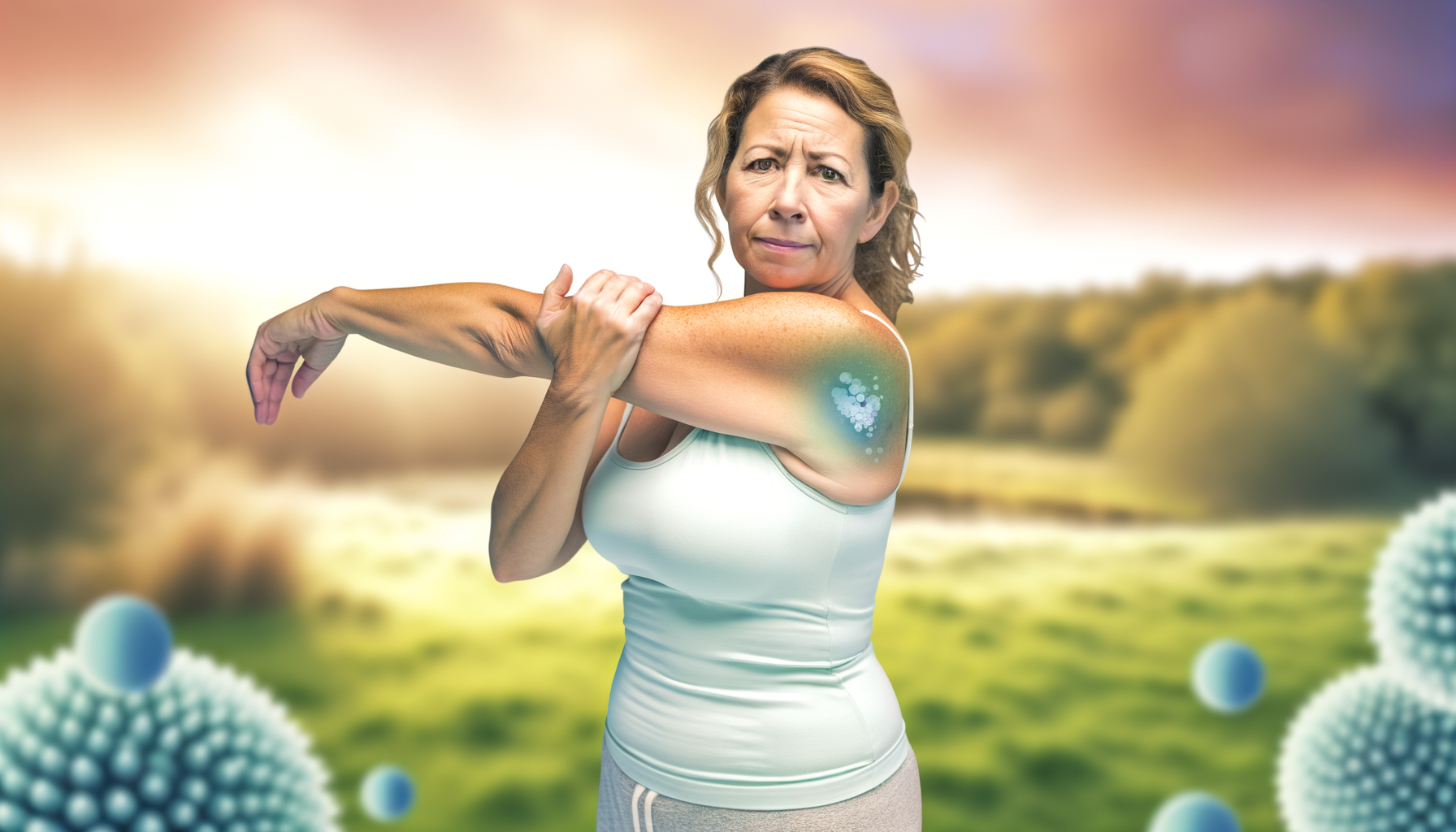Understanding Frozen Shoulder
Frozen shoulder, medically known as adhesive capsulitis, is a condition characterized by stiffness and pain in the shoulder joint. Its hallmark is the gradual onset of symptoms, which typically worsen over time before eventually starting to improve. The condition unfolds in three stages: the freezing stage, where any movement of the shoulder causes pain and its range of motion starts to become limited; the frozen stage, where the pain may decrease but the shoulder becomes stiffer and its use more difficult; and the thawing stage, where the ability to move the shoulder slowly improves. Risk factors include immobility or reduced mobility of the shoulder, certain systemic diseases, and, notably, age and sex—with a higher prevalence in women over 40 years of age.
Overview of Menopause
Menopause marks the end of a woman’s reproductive years, characterized by the cessation of menstruation and a decline in the production of hormones, especially estrogen. This transition typically occurs between the ages of 45 and 55. Menopause can lead to a variety of symptoms, including hot flashes, night sweats, mood changes, and changes in sexual function. Importantly, the hormonal changes during menopause can also impact joint health, potentially contributing to musculoskeletal conditions.
Exploring the Potential Link
While no direct evidence currently establishes a causal relationship between frozen shoulder and menopause, the hormonal changes that occur during menopause, particularly the decline in estrogen, could contribute to conditions like frozen shoulder. Estrogen is known to play a role in stimulating bone growth, reducing inflammation, and promoting connective tissue integrity. A study by Duke Health researchers found that post-menopausal women not using hormone replacement therapy had a higher risk of developing adhesive capsulitis, suggesting a potential link between estrogen decline and joint stiffness.
Purpose of the Article
The purpose of this article is to delve into the relationship between frozen shoulder and menopause, examining how hormonal changes during menopause may affect joint health and potentially lead to frozen shoulder. We will explore the pathophysiology of frozen shoulder, discuss current research on its causes, and review various treatment options, ranging from hormone replacement therapy to physical therapy and beyond. Additionally, we will consider non-medical management strategies and advanced interventions for severe cases. Our goal is to provide a comprehensive overview that can guide affected individuals and healthcare providers in the management of this condition.
Hormonal Changes During Menopause and Joint Health
Role of Estrogen in Joint Function
Estrogen, a hormone predominantly produced by the ovaries, is well-known for its role in the reproductive system. However, its influence extends to various bodily functions, including the maintenance of joint and bone health. Estrogen helps to regulate the turnover of joint cartilage and maintains the balance between the breakdown and repair of musculoskeletal tissues. It also modulates inflammation and the immune response, which are crucial in maintaining joint health. The hormone’s protective effect on bones is well-documented, as it aids in the absorption and metabolism of calcium, a key mineral for bone density and strength.
Estrogen Decline and Joint Stiffness
During menopause, the levels of estrogen decline rapidly, leading to a range of symptoms, including joint stiffness, which is experienced by more than 50% of individuals undergoing this transition. The drop in estrogen can result in decreased elasticity and moisture of connective tissues, contributing to the stiffness and discomfort in joints. While menopause typically occurs at an age when musculoskeletal issues are more common, the prevalence of joint stiffness in this demographic suggests a potential link to hormonal changes. Additionally, women are more likely to develop conditions like frozen shoulder during the menopausal years, hinting at a possible hormone-driven mechanism.
Correlation vs. Causation
Establishing a direct causal relationship between menopause and frozen shoulder is challenging due to the complexity of factors involved. While there is a correlation between the timing of menopause and the incidence of frozen shoulder, definitive evidence of causation is lacking. It is important to consider that other risk factors, such as diabetes, thyroid disease, and periods of immobilization, also contribute to the development of frozen shoulder. Therefore, while hormonal changes during menopause may play a role in joint health and conditions like frozen shoulder, they are likely part of a multifactorial process rather than the sole cause.
In summary, the hormonal upheaval during menopause, particularly the decline in estrogen, has significant implications for joint health, potentially contributing to conditions such as frozen shoulder. However, the relationship is complex, and further research is needed to fully understand the interplay between hormonal changes and musculoskeletal health.
Pathophysiology of Frozen Shoulder
Inflammatory Processes and Fibrous Tissue Development
Frozen shoulder, also known as adhesive capsulitis, is characterized by the thickening and tightening of the shoulder joint capsule, which is comprised of strong connective tissue surrounding the joint. The pathophysiology of this condition involves complex inflammatory processes that lead to the development of fibrous tissue within and around the shoulder joint. Initially, inflammation of the synovial lining of the joint capsule causes pain and sets off a cascade of events that result in the gradual loss of movement.
As the condition progresses, fibroblasts, which are cells that produce fibrous connective tissue, become more active within the joint capsule. They deposit collagen, leading to the formation of adhesions that further restrict shoulder mobility. The joint capsule thickens, and the synovial fluid, which normally lubricates the joint, diminishes. This combination of factors culminates in the hallmark symptoms of frozen shoulder: pain, stiffness, and reduced range of motion.
Stages of Frozen Shoulder
Frozen shoulder typically progresses through three distinct stages:
- The Freezing Stage: This initial stage is marked by a gradual onset of pain that worsens over time and is often more pronounced at night. The pain leads to a decrease in the use of the joint, which results in a loss of range of motion. This stage can last from 6 weeks to 9 months.
- The Frozen Stage: Although the pain may begin to subside during this stage, the shoulder remains stiff, making daily activities challenging. This stage generally persists for 4 to 6 months and is characterized by ongoing stiffness and immobility.
- The Thawing Stage: The final stage is where gradual improvement in motion occurs. The duration of the thawing stage can vary widely, ranging from 6 months to 2 years, with the shoulder slowly returning to normal or near-normal strength and mobility.
Current Research on Causes
The exact cause of frozen shoulder remains unclear, but current research suggests that it may be the result of an abnormal immune response or autoimmune condition. This response leads to inflammation and fibrous tissue buildup in the shoulder joint without a preceding injury. Factors that may increase the risk of developing frozen shoulder include diabetes, thyroid disorders, prolonged immobilization, and certain cardiovascular diseases.
While there is no direct evidence linking menopause to frozen shoulder, the hormonal changes during this period, particularly the decline in estrogen levels, could indirectly contribute to musculoskeletal conditions. Estrogen is known to have a protective effect on joint health, and its reduction during menopause could potentially exacerbate or trigger inflammatory processes in susceptible individuals. However, more research is needed to fully understand the relationship between hormonal changes in menopause and the development of frozen shoulder.
Recent studies have also explored the role of various hormones, such as thyroid hormones and calcitonin, in the development of frozen shoulder. For instance, calcitonin, which is involved in calcium metabolism, has been shown to reduce fibrous tissue buildup in the joints. This suggests that hormonal imbalances may play a role in the pathophysiology of the condition, although the exact mechanisms are still being investigated.
Treatment Options for Frozen Shoulder
Hormone Replacement Therapy (HRT)
Hormone Replacement Therapy (HRT) may offer relief for menopausal individuals experiencing joint issues, including frozen shoulder. By supplementing the body with estrogen and progesterone, HRT can potentially reduce joint pain and stiffness by mimicking the protective effects these hormones have on joint health. However, the decision to use HRT should be made after a thorough discussion with a healthcare provider, considering the benefits and potential risks.
Calcitonin Therapy
Calcitonin Therapy, involving the thyroid hormone calcitonin, may also be beneficial for those with frozen shoulder during menopause. Calcitonin helps lower calcium levels in the body, which could reduce the buildup of fibrous tissues in the joints. A 2020 review suggests that a calcitonin nasal spray can alleviate symptoms, but further research is needed to confirm its efficacy.
Dietary Considerations
Adopting certain Dietary Considerations may aid in managing frozen shoulder symptoms. A well-balanced diet, low in additives and gliadin—a protein that can increase inflammation—is recommended. Some evidence points to the potential benefits of a ketogenic diet in reducing inflammation and pain, though individual dietary needs should be assessed by a healthcare professional.
Physical Therapy and Exercise
Physical Therapy and Exercise play a critical role in the treatment of frozen shoulder. A physical therapist can tailor a program to the individual’s stage of frozen shoulder, focusing on pain control and inflammation reduction in the early stages and progressing to exercises that restore joint mobility and strength. Stretching and strengthening exercises, posture advice, and pain relief strategies are integral components of physical therapy for this condition.
Medications and Injections
Various Medications and Injections can provide temporary relief from the symptoms of frozen shoulder. Over-the-counter painkillers, corticosteroid injections, and nerve blocks are common treatments that can help manage pain and inflammation. While these interventions may offer short-term benefits, they do not address the underlying fibrous tissue buildup and should be considered as part of a comprehensive treatment plan.
It is important to note that while these treatment options can be effective, they should be personalized to the individual’s specific condition and medical history. Consulting with a healthcare professional is essential to determine the most appropriate treatment strategy for frozen shoulder, especially during or following menopause.
Non-Medical Management Strategies
Stretching and Strengthening Exercises
One of the primary non-medical strategies for managing frozen shoulder involves stretching and strengthening exercises. These exercises aim to improve the range of motion and strengthen the muscles around the shoulder joint. It is essential to perform these exercises regularly and with proper technique to avoid further injury.
- Pendulum Stretch: Lean over slightly, allowing the affected arm to hang down. Swing the arm gently in small circles and gradually increase the diameter of the swing as comfort allows.
- Towel Stretch: Hold a towel behind your back with both hands. Use the good arm to pull the affected arm upward to stretch it.
- Finger Walk: Face a wall, reach out and touch it at waist level with the fingertips of the affected arm. Walk the fingers up the wall as high as pain-free range allows, then slowly lower them.
- Cross-Body Reach: Use your good arm to lift your affected arm at the elbow and bring it up and across your body, exerting gentle pressure to stretch the shoulder.
- Armpit Stretch: Using your good arm, lift the affected arm onto a shelf about breast-high. Gently bend your knees, opening up the armpit.
It is crucial to consult with a healthcare professional before starting any new exercise regimen, especially if you have a condition like frozen shoulder.
Lifestyle Modifications
Making lifestyle modifications can also play a significant role in managing frozen shoulder. These include:
- Activity Adjustment: Avoid activities that exacerbate shoulder pain and focus on those that do not strain the shoulder joint.
- Heat Application: Applying heat to the shoulder before performing exercises can help relax the muscles and increase flexibility. A hot water bottle wrapped in a towel can be effective.
- Posture: Maintaining good posture can reduce strain on the shoulder and neck muscles.
- Stress Management: Stress can increase muscle tension, so techniques such as deep breathing, meditation, or yoga may be beneficial.
Alternative Therapies
Some individuals with frozen shoulder may find relief through alternative therapies. While these should not replace conventional treatments, they may complement them:
- Acupuncture: This traditional Chinese medicine technique involves inserting thin needles into specific points on the body to relieve pain and improve function.
- Massage Therapy: Massage can help reduce muscle tension and improve circulation, which may aid in the healing process.
- Hydrotherapy: Exercises performed in a warm pool can be less painful due to the water’s buoyancy and soothing properties.
It is important to note that the effectiveness of alternative therapies can vary from person to person, and it is always recommended to seek advice from a healthcare professional before trying these treatments.
In conclusion, non-medical management strategies for frozen shoulder focus on exercises to improve mobility and strength, lifestyle changes to reduce pain and prevent further injury, and alternative therapies that may offer additional relief. A holistic approach that combines these strategies with medical treatments can lead to better management of frozen shoulder symptoms.
Advanced Interventions for Severe Cases
Therapeutic Ultrasound
Therapeutic ultrasound is a non-invasive intervention that uses sound waves to treat frozen shoulder in severe cases. This modality aims to provide deep heating to soft tissues in the shoulder, such as muscles, tendons, joints, and ligaments. The heat can increase blood flow to the affected area, which may promote healing and reduce inflammation. It can also help to decrease pain and muscle spasms, and increase the range of motion. While therapeutic ultrasound is generally safe, it should be administered by a trained professional to ensure proper dosage and avoid potential side effects.
Surgical Options
When conservative treatments fail to provide relief for frozen shoulder, surgical options may be considered. The two primary surgical interventions are arthroscopic capsular release and manipulation under anesthesia (MUA). Arthroscopic capsular release involves making small incisions and using a camera to guide miniature instruments to remove the tight portions of the joint capsule. MUA, on the other hand, is a procedure where the shoulder is gently moved while the patient is under anesthesia to break up the adhesions. Both procedures aim to restore shoulder mobility and are typically followed by an intensive physical therapy program.
Efficacy and Risks
The efficacy of advanced interventions for frozen shoulder varies among individuals. Studies have shown that both therapeutic ultrasound and surgical options can be effective in improving shoulder function and reducing pain. However, the success of these treatments depends on several factors, including the severity of the condition, patient compliance with post-treatment rehabilitation, and the presence of any underlying medical issues.
As with any medical procedure, there are risks associated with advanced interventions for frozen shoulder. Complications from surgery can include infection, nerve injury, and stiffness. The risk of complications is generally low, but it is important for patients to discuss the potential risks and benefits with their healthcare provider. A thorough evaluation and individualized treatment plan are essential for achieving the best possible outcomes.

Conclusion: Personalized Treatment and Future Research
Summarizing the Link and Treatment Approaches
The connection between frozen shoulder and menopause is underscored by the hormonal changes that occur during menopause, particularly the decline in estrogen, which can impact joint health and contribute to the development of joint stiffness and conditions like frozen shoulder. Treatment approaches for frozen shoulder are multifaceted, ranging from hormone replacement therapy (HRT) and calcitonin therapy to dietary considerations, physical therapy, medications, injections, and advanced interventions for severe cases. These treatments aim to address the inflammatory processes, fibrous tissue development, and joint stiffness characteristic of frozen shoulder.
Importance of Individualized Care
Individualized care is paramount when treating frozen shoulder, especially in the context of menopause. Each patient’s hormonal profile, stage of menopause, and severity of frozen shoulder symptoms are unique, necessitating a tailored approach to treatment. Healthcare providers must consider the patient’s overall health, comorbidities, lifestyle, and personal preferences when developing a treatment plan. This personalized approach ensures that patients receive the most effective and appropriate care for their specific situation, leading to better outcomes and improved quality of life.
Areas for Future Study
While the link between frozen shoulder and menopause has been established, there is still much to learn. Future research should focus on:
- Longitudinal studies: To better understand the progression of frozen shoulder in relation to hormonal changes during menopause.
- Genetic factors: Investigating the role of genetics in the susceptibility to frozen shoulder among menopausal women.
- Alternative therapies: Exploring the efficacy of complementary and alternative medicine in treating frozen shoulder, particularly in menopausal patients.
- Preventive strategies: Developing and testing preventive measures that could reduce the incidence of frozen shoulder in the menopausal population.
- Impact of lifestyle modifications: Assessing how changes in diet, exercise, and other lifestyle factors can influence the management and prognosis of frozen shoulder during menopause.
By continuing to explore these areas, the medical community can enhance its understanding of frozen shoulder and menopause, leading to more effective treatments and potentially preventive strategies for those at risk.









